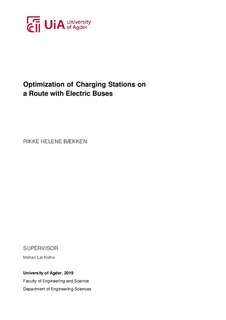| dc.contributor.author | Bækken, Rikke Helene | |
| dc.date.accessioned | 2019-10-16T09:07:17Z | |
| dc.date.available | 2019-10-16T09:07:17Z | |
| dc.date.issued | 2019 | |
| dc.identifier.uri | http://hdl.handle.net/11250/2622472 | |
| dc.description | Master's thesis Renewable Energy ENE500 - University of Agder 2019 | nb_NO |
| dc.description.abstract | This studyconsiders placement of electric charging stations for a public electric bus system with the intention of minimizing the charging power. This is an optimization problem where fully electric buses with opportunity charging strategy are considered.The developed strategies are proposed for an existing bus route in Oslo city, Norway. Batteryand chargingspecifications were determinedbased on a literature review. Measurements regarding velocity of the bus and altitude of the route were performed. This data where further used to determine the energy needsfor an electric bus. Four cases were formedregarding different battery capacities, desired end battery levels,maximum charging powersand end stop regulation times.Further,amathematicalmodel was developedand verified in order to solve the optimization. The optimization model was developed in terms of anobjective functionwith the intention of minimizing the charging power subject to constraintsregarding battery operation ranges and charging power restrictions.The four optimized cases showed that electric buses with opportunity charging strategyis possibleforthe selected route.Three of the cases were optimized to havetwo charging stationsat each end stop. Thecharging powerat each stationwasreduced by havinglower desired end battery level and lower battery capacity. The optimized placement of the charging stations wasat those bus stops where the bus stand for the longest time. To minimize the charging power each station should be distributed with equal charging powers. Another measure may be to include externalbatteries connected to the charging stations.Bus route characteristics, driving cycles and available grid capacity are essential considerations when planning an electric bus system. As for further works, it willbe interesting to develop the optimization model tohave the possibility ofoperating with multiple electric bus routes. By doing so,the system will beconsideredin a wider perspective giving the opportunity to plan a more accurate an effective electric bus system. | nb_NO |
| dc.language.iso | eng | nb_NO |
| dc.publisher | Universitetet i Agder ; University of Agder | nb_NO |
| dc.rights | Attribution-NonCommercial-NoDerivatives 4.0 Internasjonal | * |
| dc.rights.uri | http://creativecommons.org/licenses/by-nc-nd/4.0/deed.no | * |
| dc.subject | ENE500 | nb_NO |
| dc.title | Optimization of Charging Stations on a Route with Electric Buses | nb_NO |
| dc.type | Master thesis | nb_NO |
| dc.subject.nsi | VDP::Teknologi: 500::Elektrotekniske fag: 540 | nb_NO |
| dc.source.pagenumber | 115 p. | nb_NO |

